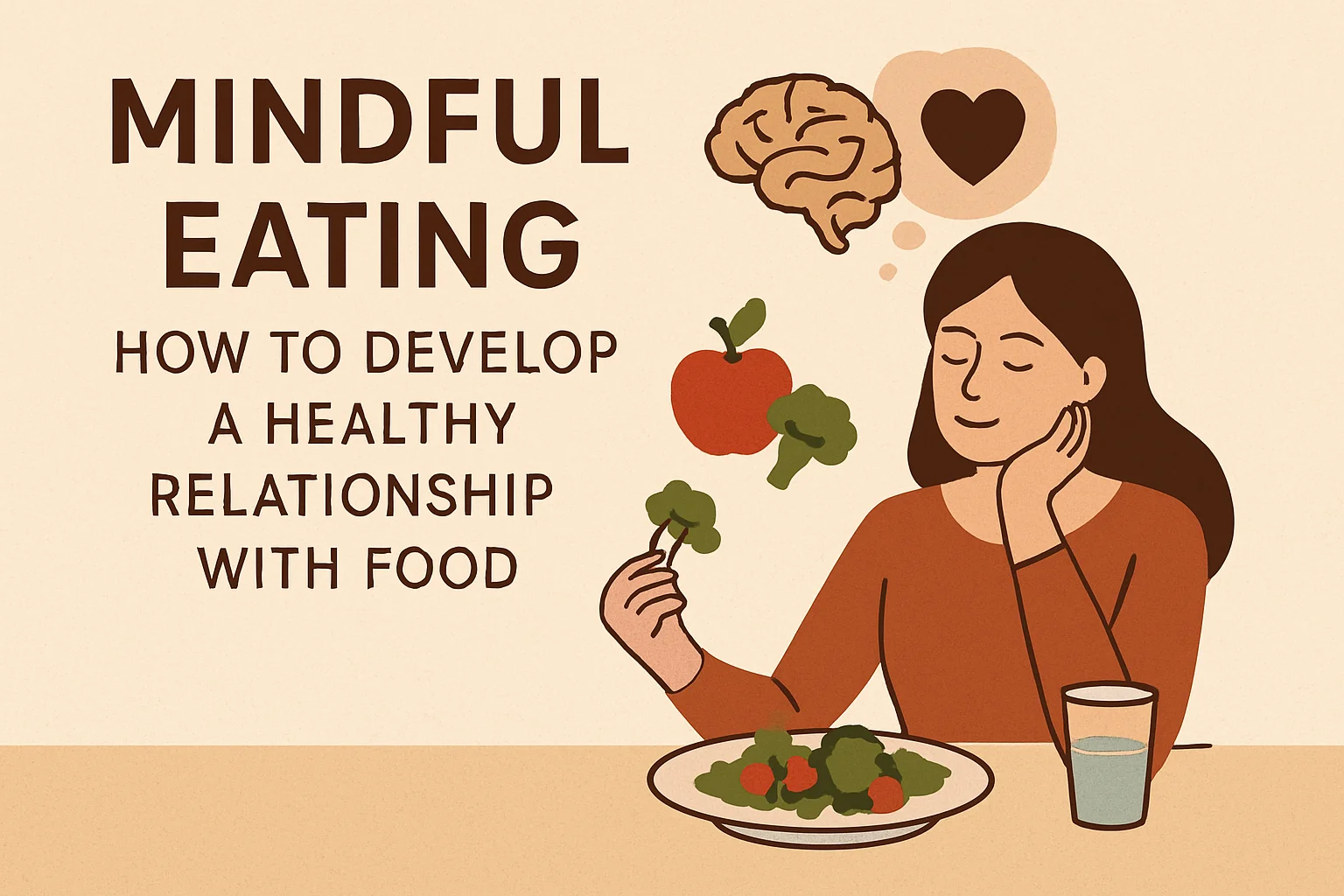In today’s fast-paced world, eating has become more of a routine than a mindful experience. Many people consume their meals while distracted, whether scrolling through their phones, watching TV, or rushing through their day. This mindless approach to eating can lead to overeating, poor digestion, and an unhealthy relationship with food.
Mindful eating is the practice of being fully present during meals, paying attention to hunger and fullness cues, and appreciating the flavors and textures of food. It is not about dieting or restrictions but about fostering a balanced and positive connection with what we eat. By practicing mindful eating, individuals can improve digestion, prevent overeating, and cultivate a healthier lifestyle.
In this article, we will explore the fundamentals of mindful eating, practical techniques to incorporate it into daily life, and the long-term benefits it offers for both physical and mental well-being.
Understanding Mindful Eating: The Key to a Balanced Diet

In today’s fast-paced world, eating has often become a mindless activity—something we do while scrolling through our phones, working at our desks, or watching TV. This disconnect between our bodies and our food can lead to overeating, poor digestion, and an unhealthy relationship with what we consume. Mindful eating offers a solution by bringing awareness back to the act of eating, helping us develop a healthier, more balanced approach to nutrition.
What Is Mindful Eating?
Mindful eating is the practice of paying full attention to the experience of eating—engaging all your senses, recognizing hunger and fullness cues, and making intentional food choices without judgment. Rooted in mindfulness meditation, this approach encourages a deeper connection with food, allowing us to appreciate its flavors, textures, and nourishment.
Unlike restrictive diets that focus on rules and limitations, mindful eating emphasizes:
- Listening to your body’s hunger and fullness signals
- Eating slowly and savoring each bite
- Recognizing emotional vs. physical hunger
- Choosing foods that satisfy and energize you
The Benefits of a Mindful Approach to Eating
Research shows that mindful eating can lead to numerous physical and psychological benefits, including:
✅ Better digestion – Eating slowly improves nutrient absorption and reduces bloating.
✅ Weight management – Tuning into hunger cues helps prevent overeating.
✅ Reduced stress around food – Eliminates guilt and fosters a positive relationship with eating.
✅ Enhanced enjoyment of meals – Savoring flavors leads to greater satisfaction with smaller portions.
How to Practice Mindful Eating
- Start with a Pause – Before eating, take a deep breath and check in with your hunger levels.
- Engage Your Senses – Notice the colors, smells, and textures of your food.
- Eat Slowly – Put your fork down between bites and chew thoroughly.
- Avoid Distractions – Turn off screens and focus solely on your meal.
- Recognize Fullness – Stop eating when you feel comfortably satisfied, not stuffed.
The First Step Toward a Healthier Relationship with Food
Mindful eating isn’t about perfection—it’s about awareness. By slowing down and truly experiencing your meals, you can break free from unhealthy eating patterns and develop a more balanced, joyful approach to food.
But what happens when emotions drive our eating habits?
Practical Tips to Cultivate Mindful Eating Habits

Understanding mindful eating is one thing—but how do you actually put it into practice in your daily life? Many of us are used to rushed meals, distracted eating, and ignoring our body’s signals. The good news is that with a few simple strategies, you can transform your eating habits and develop a more mindful, satisfying relationship with food.
Why Mindful Eating Requires Practice
Mindless eating is often a result of habits built over years—eating on autopilot, multitasking during meals, or turning to food for comfort. To shift these patterns, we need intentional, consistent practices that bring awareness back to our meals.
Here are some practical, actionable tips to help you eat more mindfully:
1. Create a Calm Eating Environment
- Sit down at a table (avoid eating while standing or walking).
- Minimize distractions—turn off the TV, put away your phone, and focus solely on your meal.
- Use proper dishes instead of eating straight from packages to encourage slower, more deliberate eating.
2. Slow Down and Savor Each Bite
- Chew thoroughly (aim for 20-30 chews per bite).
- Put your fork down between bites to pace yourself.
- Take small sips of water throughout the meal to slow your eating speed.
3. Tune Into Your Hunger & Fullness Cues
- Before eating, ask yourself: “Am I truly hungry, or am I eating out of habit, boredom, or emotion?”
- Use the Hunger Scale:
- 1–3: Ravenous (leads to overeating)
- 4–6: Comfortably hungry (ideal time to eat)
- 7–8: Satisfied (time to stop)
- 9–10: Stuffed (uncomfortably full)
- Pause halfway through your meal to check in with your fullness level.
4. Engage All Your Senses
- Notice the colors, smells, and textures of your food.
- Take the first few bites in silence, truly tasting the flavors.
- Appreciate where your food comes from—think about the effort behind its preparation.
5. Manage Emotional Eating Triggers
- Keep a food-mood journal to track when and why you eat (e.g., stress, boredom, sadness).
- Find alternative coping mechanisms—take a walk, drink tea, or practice deep breathing instead of turning to food.
- Ask yourself: “Will this food truly satisfy me, or am I seeking comfort?”
6. Practice Gratitude for Your Food
- Take a moment before eating to express gratitude—whether silently or out loud.
- Reflect on the nourishment your meal provides, fostering a positive mindset around eating.
Small Changes, Big Impact
Mindful eating doesn’t require a complete lifestyle overhaul—small, consistent shifts can lead to lasting change. Start with just one or two of these tips and gradually incorporate more as they become habits.
But what if your cravings feel uncontrollable?
The Benefits of Mindful Eating for Physical and Mental Well-being

Mindful eating is more than just a trend—it’s a powerful tool that can transform both your body and mind. By shifting from autopilot eating to conscious nourishment, you unlock a range of benefits that go far beyond weight management. Let’s explore how mindful eating enhances physical health, emotional balance, and overall well-being.
1. Improved Digestion & Gut Health
When you eat slowly and chew thoroughly, you:
✅ Stimulate digestive enzymes for better nutrient absorption
✅ Reduce bloating and discomfort by preventing rushed eating and air swallowing
✅ Enhance gut-brain communication, which supports a healthier microbiome
Tip: Try putting your fork down between bites to naturally slow your eating pace.
2. Sustainable Weight Management
Unlike restrictive diets, mindful eating helps you:
✅ Recognize true hunger vs. emotional cravings
✅ Stop eating when comfortably full (not stuffed)
✅ Break free from binge-restrict cycles by removing food guilt
Research shows that mindful eating leads to more stable, long-term weight balance than calorie-counting diets.
3. Reduced Stress & Emotional Eating
Mindful eating strengthens your relationship with food by:
✅ Breaking the stress-eating cycle through greater self-awareness
✅ Lowering cortisol levels (the stress hormone linked to belly fat)
✅ Helping you savor food instead of using it as a coping mechanism
Example: Noticing that you reach for snacks when anxious? A 5-minute breathing exercise may satisfy that urge more effectively than mindless munching.
4. Enhanced Mental Clarity & Energy
By choosing foods that truly nourish you, you’ll experience:
✅ Stable blood sugar levels (no more afternoon crashes)
✅ Sharper focus from avoiding processed food fog
✅ More energy as your body efficiently uses nutrients
Pro tip: Notice how different foods make you feel—does that sugary snack energize you or leave you sluggish?
5. Greater Appreciation for Food & Life
Mindful eating cultivates gratitude by:
✅ Deepening enjoyment of flavors and textures
✅ Connecting you to food’s journey (farm to table)
✅ Making meals a joyful ritual, not just fuel
A Holistic Approach to Well-being

Mindful eating isn’t just about what you eat—it’s about how you eat. By bringing awareness to your meals, you nourish both body and mind, creating a sustainable path to health that feels empowering, not restrictive.
But how do you maintain this practice in social situations or at restaurants?
